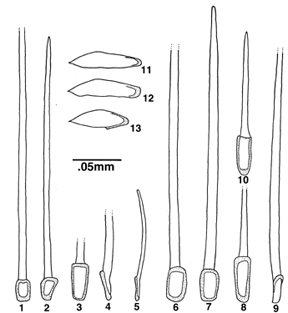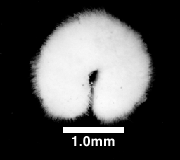Type
locality. -- West European Basin 50¡19.3'N, 12¡55.8'W, 2,498
m (INCAL [CENTOB] WS-02, 30.vii.76).
Holotype. -- MNHN (alcohol specimen, spicule slide). Length 3.2 mm,
height and width at midbody 0.8 and 1.0 mm, respectively.
Etymology. -- macello = a pick; aciculata = like a small
needle
Very
spiny with thickset spicules, contracted body usually tightly curved, length
to a little over 3 mm, of nearly equal height and width throughout, to
1.0 mm in diameter; rounded anteriorly and posteriorly; area around mouth
and mantle cavity opening flattened, contracted mouth and mantle cavity
openings longitudinal slits (Fig. 12B); pedal groove covered by long spicules.
Epidermis 25 µm thick to 30 µm beside pedal groove, with many
unstalked papillae, cuticle one-half as thick as epidermis, 12 µm;
body wall musculature thin; vestibular papillae long, 18 or 20 in number,
with long cilia at opening to vestibule, mouth opening at back of vestibule;
pedal glands voluminous, pedal pit large, filling one-third of space in
cross-section, with long cilia; foot single ridge 62 µm in height;
single duct of ventral salivary glands above and of greater diameter than
radular sac; midgut sacculate, no nematocysts observed; with 3 pairs of
deep respiratory folds.
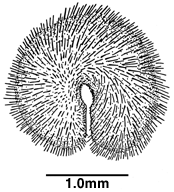
Pedestal
of epidermal spicules rectangular (spicules 1, 6, 7) to trapezoidal (spicules
3, 8), curved against body, varying from 20 to 47 µm in greatest
dimension by 13 to 20 µm, sometimes incompletely formed (spicule
9); solid needles straight or nearly so, greatest length to more than 300
µm, greatest width to 11 µm; pedestal dimensions not correlated
to needle length (cf. spicules 1, 10); spicules from beside pedal groove
of two types: (1) flat, thin, curved, in single longitudinal row, distally
sharply pointed, proximally rimmed with rim sometimes abruptly terminated
at an angle to rest of spicule (spicules 11-13); (2) numerous short, curved
needles lateral to flattened spicules, <100 µm long by 5 µm
wide with rimmed pedestals 11 µm long (spicule 5).
One
isolated radula examined: tiny, 58 µm total length, with 16 rows
of 15-µm long bars bearing 5 denticles; radular sac and odontophore
49 µm in length in histologic sections.
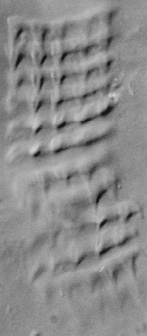

Reproductive
system. -- No specialized spicules were observed at mantle cavity opening.
The reproductive system posterior to the gonads is dominated by two large
tubular seminal receptacles 140 to 180 µm long by 130 µm at
their broadest (Figure above). These seem to be the elongated horns of
the shell gland "longer than itself" described by Pruvot (1891) for Macellomenia
palifera. The seminal receptacles are connected to the gametoducts
through a narrow, muscular duct which seems to join the upper gametoduct
on its ventral side posterior to its union with the lower gametoduct, although
the connection was not clearly seen. The lower gametoducts are united for
most of their length, which about equals that of the seminal receptacles.
The exits from the pericardial cavity into the upper gametoducts are not
from the usual terminal end of the pericardium, but from a distance only
one-third of the way from the anterior end of the pericardium, as described
by Pruvot for M. palifera.
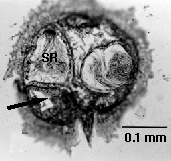
Remarks.
-- The genus
Macellomenia is unique in the form of the spicules,
with the adpressed pedestals perhaps functioning as skeletal spicules,
and in the form of the radula.
M. aciculata apparently is not a
cnidarivore. It differs from a species of
Macellomenia referred
to
M. palifera (Pruvot) reported from the Irish Sea (Caudwell et
al., 1995) in smaller size, stubbier body shape, longer spines, and rectangular
rather than ovate pedestals.
M. aciculata differs from
M. palifera
s.s. in number of tooth denticles, smaller body size, shape of spicule
pedestal, and spicule length.
From Ophelia 51 (1): 1-28 (1999).
Macellomenia aciculata Scheltema, 1999


